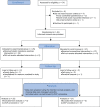Effects of elastic resistance exercise on body composition and physical capacity in older women with sarcopenic obesity: A CONSORT-compliant prospective randomized controlled trial
- PMID: 28591061
- PMCID: PMC5466239
- DOI: 10.1097/MD.0000000000007115
Effects of elastic resistance exercise on body composition and physical capacity in older women with sarcopenic obesity: A CONSORT-compliant prospective randomized controlled trial
Abstract
Background: Sarcopenia is associated with loss of muscle mass and an increased risk of physical disability in elderly people. However, the prevalence of sarcopenia has increased in obese elderly populations. The purpose of this study was to identify the clinical efficacy of elastic resistance exercise training (RET) in patients with sarcopenic obesity.
Methods: This study was conducted at the rehabilitation center of a university-based teaching hospital and was designed as a prospective and randomized controlled trial with an intention-to-treat analysis. A total of 46 women aged 67.3 (5.2) years were randomly assigned to an experimental group (EG) and control group (CG). The EG underwent elastic RET for 12 weeks, and the CG received no RET intervention. All outcome measures were assessed at the baseline and posttest, including body composition measured using dual-energy X-ray absorptiometry, muscle quality (MQ) defined as a ratio of muscular strength to muscle mass, and physical capacity assessed using functional mobility tests. One-way analysis of covariance and Pearson correlation were used to compare outcomes between the 2 groups and to identify the relationship between changes in body composition and physical outcomes, respectively. A chi-square test was performed to identify differences in qualitative data between the 2 groups.
Results: At the posttest, a significant between-group difference was observed in fat-free mass, MQ, and physical capacity (all P < .05); and a significant correlation was found between leg-lean-mass change and gait speed (r = 0.36; P < .05). After 12 weeks of elastic RET intervention, the EG had significantly fewer patients exhibiting sarcopenia (P < .05) and experiencing physical difficulty (P < .001) than the CG.
Conclusion: The present data suggest that elastic resistance exercise exerted benefits on the body composition, MQ, and physical function in patients with sarcopenic obesity. Regular exercise incorporating elastic RET should be used to attenuate muscle mass loss and prevent physical difficulty in obese older adults with sarcopenia on reconditioning therapy.
Trial registration: Chinese Clinical Trial Registry, ChiCTR-IPR-15006069.
Conflict of interest statement
The authors have no conflicts of interest to disclose.
Figures
References
-
- Janssen I, Baumgartner RN, Ross R, et al. Skeletal muscle cutpoints associated with elevated physical disability risk in older men and women. Am J Epidemiol 2004;159:413–21. - PubMed
-
- Visser M, Deeg DJ, Lips P, et al. Skeletal muscle mass and muscle strength in relation to lower-extremity performance in older men and women. J Am Geriatr Soc 2000;48:381–6. - PubMed
-
- Vincent HK, Vincent KR, Lamb KM. Obesity and mobility disability in the older adult. Obes Rev 2010;11:568–79. - PubMed
Publication types
MeSH terms
LinkOut - more resources
Full Text Sources
Other Literature Sources
Medical


